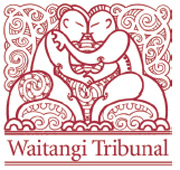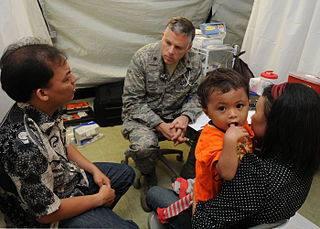Related Research Articles

A registered nurse (RN) is a nurse who has graduated from a nursing program and met the requirements outlined by a country, state, province or similar government-authorized licensing body to obtain a nursing license. An RN's scope of practice is determined by legislation, and is regulated by a professional body or council.
Taonga or taoka is a Māori language word which refers to a treasured possession in Māori culture. Due to the lack of a direct translation to English and the significance of its use in the Treaty of Waitangi, the word has been widely adopted into New Zealand English as a loanword. The current definition differs from the historical definition, noted by Hongi Hika as "property procured by the spear" [one could understand this as war booty or defended property] and is now interpreted to mean a wide range of tangible and intangible possessions, especially items of historical cultural significance.
The Māori language revival is a movement to promote, reinforce and strengthen the use of te reo Māori, the Māori language. Primarily in New Zealand, but also in places with large numbers of expatriate New Zealanders, the movement aims to increase the use of Māori in the home, in education, government and business. The movement is part of a broader revival of tikanga Māori in what has been called the Māori renaissance.

Waitangi Day, the national day of New Zealand, marks the anniversary of the initial signing – on 6 February 1840 – of the Treaty of Waitangi, which is regarded as the founding document of the nation. The first Waitangi Day was not celebrated until 1934, and it was made a national public holiday in 1974.

The Waitangi Tribunal is a New Zealand permanent commission of inquiry established under the Treaty of Waitangi Act 1975. It is charged with investigating and making recommendations on claims brought by Māori relating to actions or omissions of the Crown, in the period largely since 1840, that breach the promises made in the Treaty of Waitangi. The Tribunal is not a court of law; therefore, the Tribunal's recommendations and findings are not binding on the Crown. They are sometimes not acted on, for instance in the foreshore and seabed dispute.
Tikanga is a Māori concept incorporating practices and values from mātauranga Māori, Māori knowledge. Tikanga is translated into the English language with a wide range of meanings — culture, custom, ethic, etiquette, fashion, formality, lore, manner, meaning, mechanism, method, protocol, style, customary law.
Nurse education consists of the theoretical and practical training provided to nurses with the purpose to prepare them for their duties as nursing care professionals. This education is provided to student nurses by experienced nurses and other medical professionals who have qualified or experienced for educational tasks, traditionally in Nursing schools. Most countries offer nurse education courses that can be relevant to general nursing or to specialized areas including mental health nursing, pediatric nursing and post-operatory nursing. Courses leading to autonomous registration as a nurse typically last four years. Nurse education also provides post-qualification courses in specialist subjects within nursing.

A nurse practitioner (NP) is an advanced practice registered nurse and a type of mid-level practitioner. NPs are trained to assess patient needs, order and interpret diagnostic and laboratory tests, diagnose disease, formulate and prescribe medications and treatment plans. NP training covers basic disease prevention, coordination of care, and health promotion, but does not provide the depth of expertise needed to recognize more complex conditions.
Faith Community Nursing, also known as Parish Nursing, Parrish Nursing, Congregational Nursing or Church Nursing, is a movement of over 15,000 registered nurses, primarily in the United States. There are also Parish nurses in Australia, the Bahamas, Canada, England, Ghana, India, Kenya, Korea, Madagascar, Malawi, Malaysia, New Zealand, Nigeria, Palestine, Pakistan, Scotland, Singapore, South Africa, Swaziland, Ukraine, Wales, Zambia and Zimbabwe. Faith community nursing is a practice specialty that focuses on the intentional care of the spirit, promotion of an integrative model of health and prevention and minimization of illness within the context of a community of faith. The intentional integration of the practice of faith with the practice of nursing so that people can achieve wholeness in, with, and through the population which faith community nurses serve.

Gerontological nursing is the specialty of nursing pertaining to older adults. Gerontological nurses work in collaboration with older adults, their families, and communities to support healthy aging, maximum functioning, and quality of life. The term gerontological nursing, which replaced the term geriatric nursing in the 1970s, is seen as being more consistent with the specialty's broader focus on health and wellness, in addition to illness.
Transcultural nursing is how professional nursing interacts with the concept of culture. Based in anthropology and nursing, it is supported by nursing theory, research, and practice. It is a specific cognitive specialty in nursing that focuses on global cultures and comparative cultural caring, health, and nursing phenomena. It was established in 1955 as a formal area of inquiry and practice. It is a body of knowledge that assists in providing culturally appropriate nursing care.
Nursing is a profession within the health care sector focused on the care of individuals, families, and communities so they may attain, maintain, or recover optimal health and quality of life. They also take on vital roles of education, assessing situations, as support. Nurses may be differentiated from other health care providers by their approach to patient care, training, and scope of practice. Nurses practice in many specialties with differing levels of prescription authority. Nurses comprise the largest component of most healthcare environments; but there is evidence of international shortages of qualified nurses. Many nurses provide care within the ordering scope of physicians, and this traditional role has shaped the public image of nurses as care providers. Nurse practitioners are nurses with a graduate degree in advanced practice nursing. They are however permitted by most jurisdictions to practice independently in a variety of settings. Since the postwar period, nurse education has undergone a process of diversification towards advanced and specialized credentials, and many of the traditional regulations and provider roles are changing.
Nursing in New Zealand is a specialist career with advanced educational requirements. Since the 19th century, the profession has evolved from on-the-job training in hospitals to a degree-level profession studied in technical institutes and universities. Due to New Zealand's geographic and geopolitical position, the country's nursing profession is both the subject of brain drain to larger nations and the recipient of brain drain from others.

The Māori are the indigenous Polynesian people of mainland New Zealand. Māori originated with settlers from East Polynesia, who arrived in New Zealand in several waves of canoe voyages between roughly 1320 and 1350. Over several centuries in isolation, these settlers developed their own distinctive culture, whose language, mythology, crafts, and performing arts evolved independently from those of other eastern Polynesian cultures. Some early Māori moved to the Chatham Islands, where their descendants became New Zealand's other indigenous Polynesian ethnic group, the Moriori.

Holistic nursing is a way of treating and taking care the patient as a whole body which involves physical, social environment, psychological, cultural and religious beliefs. There are many theories that support the importance of nurses approaching the patient holistically and how education on this are there to support the goal of holistic nursing. The important skill to be used in holistic nursing would be communicating skills with patients and other practitioners. This emphasizes that patients being treated would be treated not only their body but also mind and spirit.. Holistic nursing is a nursing speciality concerning the integration of one's mind, body, and spirit with his or her environment. This speciality has a theoretical basis in a few grand nursing theories, most notably the science of unitary human beings, as published by Martha E. Rogers in An Introduction to the Theoretical Basis of Nursing, and the mid-range theory Empowered Holistic Nursing Education, as published by Dr. Katie Love. Holistic nursing has gained recognition by the American Nurses Association (ANA) as a nursing specialty with a defined scope of practice and standards. Holistic nursing focuses on the mind, body, and spirit working together as a whole and how spiritual awareness in nursing can help heal illness. Holistic medicine focuses on maintaining optimum well-being and preventing rather than just treating disease.
The timeline of nursing history in Australia and New Zealand stretches from the 19th century to the present.
Structural discrimination occurs in a society "when an entire network of rules and practices disadvantages less empowered groups while serving at the same time to advantage the dominant group". The Human Rights Commission in New Zealand have asserted that there is strong, consistent evidence that structural discrimination is a real and ongoing issue in the country. The commission has acknowledged the importance of addressing institutional barriers within New Zealand's social institutions, stating that these barriers help to create social inequalities which in turn limit the access to and fulfillment of New Zealand's human rights obligations.

Cultural competence in healthcare refers to the ability for healthcare professionals to demonstrate cultural competence toward patients with diverse values, beliefs, and feelings. This process includes consideration of the individual social, cultural, and psychological needs of patients for effective cross-cultural communication with their health care providers. The goal of cultural competence in health care is to reduce health disparities and to provide optimal care to patients regardless of their race, gender, ethnic background, native languages spoken, and religious or cultural beliefs. Cultural competency training is important in health care fields where human interaction is common, including medicine, nursing, allied health, mental health, social work, pharmacy, oral health, and public health fields.
Irihapeti Merenia Ramsden was a New Zealand Māori nurse, anthropologist, and writer who worked to improve health outcomes for Māori people.
Virtual reality is the creation of a three-dimensional, interactive environment. With this technology, users are able to move through this developed simulation, as if it is real.
References
- ↑ "Guidelines for Cultural Safety, the Treaty of Waitangi and Māori Health in Nursing Education and Practice" (PDF). Nursing Council of New Zealand. Retrieved 17 February 2020.
- ↑ "Kawa Whakaruruhau: Cultural Safety" (PDF). Treaty Resource Centre. Retrieved 17 February 2020.
- 1 2 Gerlach, Alison (1 June 2012). "A critical reflection on the concept of cultural safety". Canadian Journal of Occupational Therapy. 79 (3): 151–8. doi:10.2182/cjot.2012.79.3.4. PMID 22822692. S2CID 23261789.
- 1 2 "Guidelines for cultural safety". New Zealand Psychologists Board. 13 July 2010. Retrieved 24 June 2020.
- ↑ Nursing Council of New Zealand. (n.d). Treaty of Waitangi. Retrieved from http://www.nursingcouncil.org.nz/About-us/Treaty-of-Waitangi
- ↑ KITCHIN, P. (2003, Apr 10). Architect of cultural safety. Dominion Post
- ↑ "Williams,R (1999).Cultural safety — what does it mean for our work practice? Vol23/2 Australia and New Zealand Journal of Public Health" (PDF). This article states that the phrase was originally coined by Maori nurses.
- ↑ Brascoupé, Simon (2009). "Cultural Safety: Exploring the Applicability of the Concept of Cultural Safety to Aboriginal Health and Community Wellness". International Journal of Indigenous Health. 5: 6–41. S2CID 6412969.
- ↑ JOHNSON, A. (2002, Dec 23). Training `skewed' to maori. Dominion Post
- 1 2 Richardson, Frances (2010). "Cultural safety in nursing education and practice in Aotearoa New Zealand" (PDF). Retrieved 24 June 2020.
- ↑ "Deborah Coddington: Nats, look at your own PC trail".
- ↑ WELLWOOD, E. (1998, Apr 30). Penn `delighted' by NZ nursing council decision. The Press
- 1 2 Reverse racism at Wanganui polytech. (Apr 28 1997). Evening Post
- ↑ Stabb, Brian (May 1995). "How I became culturally unsafe" (PDF). Nursing New Zealand. Kai Tiaki: Nursing New Zealand. 1 (4): 24–6. PMID 7664204 . Retrieved 24 June 2020.
- ↑ Du Chateau, S. (1992). Culture Shock. Metro. June, 96-106
Dominion Post [Wellington, New Zealand] 23 Aug 1997. 2nd ed. Cultural Safety.
Wepa, D (ed) 2005 Cultural safety in Aotearoa New Zealand. Auckland. Pearson Education